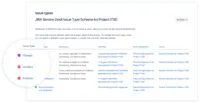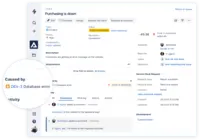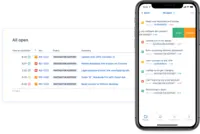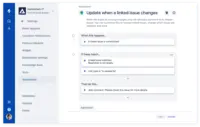Jira Service ManagementFormerly Jira Service Desk
Overview
What is Jira Service Management?
Jira Service Management (formerly Jira Service Desk, now including features from the former Mindville Insight, acquired by Atlassian in June 2020) is a service desk software that is purpose-built for IT, service, and support teams. The software provides everything IT…
Beware JIRA ITSM pricing increase.
Modern and Easy to collaborate ITSM tool
A Great Way to Manage your Tickets
A Few Tweaks, Or Ability To Tweak, Would Make This Product Great To Work With
Jira helps keep your team organized
In depth project management tool
IT Issues Goodbye!
Perfect management and centralized system service
Best Service I Ever Used
JIRA: The tool for immediate support
Jira
Great tool for project management and task-tracking
A Solid Product for internal-use Jira Service Desks across Departments
Modern simple service desk sofware that anybody can use
One stop for all of your service desk issues
Awards
Products that are considered exceptional by their customers based on a variety of criteria win TrustRadius awards. Learn more about the types of TrustRadius awards to make the best purchase decision. More about TrustRadius Awards
Popular Features
- Organize and prioritize service tickets (74)8.383%
- Service-level management (67)8.282%
- Change requests repository (63)7.373%
- Self-service tools (68)7.272%
Reviewer Pros & Cons
Pricing
Free
$0
Standard
$20
Premium
$40
Entry-level set up fee?
- No setup fee
Offerings
- Free Trial
- Free/Freemium Version
- Premium Consulting/Integration Services
Features
Incident and problem management
Streamlining ticketing and service restoration processes
- 8.3Organize and prioritize service tickets(74) Ratings
Prioritize tickets to ensure most urgent are tackled first
- 9Expert directory(2) Ratings
Directory of IT and businesses services available to customers to help route tickets to appropriate subject matter experts
- 9.5Service restoration(2) Ratings
Impact assessment and automated fixes for common problems
- 7.2Self-service tools(68) Ratings
Repository of information documenting common issues and known resolutions which can be accessed directly by users
- 10Subscription-based notifications(1) Ratings
Users subscribe to notifications for ticket updates
- 7.7ITSM collaboration and documentation(61) Ratings
Issue resolution through collaboration mechanisms like discussion threads, social tools; agents can attach notes, files, etc. to tickets in order to maintain a record of all interactions related to the case.
- 5.8ITSM reports and dashboards(62) Ratings
Reports and dashboards are used to optimize service desk operations by supplying key performance and capacity data
ITSM asset management
Managing all IT assets and enforcing policy rules
- 10Configuration mangement(1) Ratings
Database for tracking and reporting all business assets
- 10Asset management dashboard(1) Ratings
Dashboard showing organization's software portfolio
- 10Policy and contract enforcement(1) Ratings
Ensuring that requesters have eligibility before fullfullment
Change management
Ensuring standardized processes for making changes to IT infrastructure
- 7.3Change requests repository(63) Ratings
Single repository of all planned changes and releases
- 6.5Change calendar(2) Ratings
Calendar showing change schedule to stakeholders
- 8.2Service-level management(67) Ratings
Process for negotiating agreements regarding service level expectations, and ensuring these are met
Product Details
- About
- Competitors
- Tech Details
- FAQs
What is Jira Service Management?
Jira Service Management Features
Incident and problem management Features
- Supported: Organize and prioritize service tickets
- Supported: Self-service tools
- Supported: ITSM collaboration and documentation
- Supported: ITSM reports and dashboards
Change management Features
- Supported: Change requests repository
- Supported: Service-level management
Additional Features
- Supported: Custom reporting
- Supported: Self-service Help Center
- Supported: Automation rules
- Supported: ITIL-certified
- Supported: Email support
- Supported: Pre-built workflows
- Supported: SLA's
- Supported: CSAT reporting
- Supported: Asset management integration
Jira Service Management Screenshots
Jira Service Management Competitors
Jira Service Management Technical Details
| Deployment Types | Software as a Service (SaaS), Cloud, or Web-Based |
|---|---|
| Operating Systems | Unspecified |
| Mobile Application | Apple iOS, Android |
| Supported Languages | English, French, Spanish, German, Portuguese (Brazil), Portuguese (Portugal), Russian, Korean, Japanese, Norwegian, Polish, Chinese, Czech, Danish, Dutch, Estonian, Finnish, Hungarian, Icelandic, Romanian, Slovak, Swedish, Vietnamese |
Frequently Asked Questions
Comparisons
Compare with
Reviews and Ratings
(623)Community Insights
- Business Problems Solved
- Pros
- Cons
- Recommendations
Jira Service Desk is a versatile ticketing system that has become the primary solution for managing requests and communication within our organization. It effectively addresses the challenge of handling a large volume of requests and provides a centralized platform for storing and accessing information. Users have found it valuable due to its customizable nature, allowing it to adapt to the specific needs of different departments.
With Jira Service Desk, multiple departments across the organization, such as Client Service, Financial Service, and Tech Engineering, efficiently handle ticketing and tracking tasks. It replaces legacy tools with limited reporting capabilities, facilitating improved processes and workflows. The user-friendly interface makes it easy for both technical and non-technical individuals to navigate and utilize the system effectively.
Jira Service Desk streamlines communication by providing users with an intuitive platform to view and update their tickets easily. It improves transparency among teams by tracking SLA metrics, utilization, incidents, trends, and other key performance indicators. Additionally, Jira Service Desk serves as a documentation tool for projects, enabling the tracking of incoming issues or requests.
By utilizing Jira Service Desk, organizations can streamline internal and external requests and complaints while reducing resolution time. Its efficient helpdesk ticketing system simplifies collaboration between teams and departments. With its customizable workflows and integration with other software tools, Jira enables teams to manage workloads, pre-plan tasks, track progress, assign tickets to team members, and ensure efficient delivery.
Overall, Jira Service Desk is widely used across organizations to improve efficiency in various departments such as IT support, HR, Accounting, Marketing, Sales, and Service Delivery. Its flexibility in customizing workflows allows teams of any size to configure the system according to their specific needs while providing a central location for issue tracking and project management.
Sufficient Communication and Accountability Features: Users have appreciated the tool's sufficient communication and accountability features, which have prevented replication of tasks and decisions. This has eliminated the need to constantly bother the project lead for updates and allowed for easy tracking of completed tasks and discussions.
Versatile Task Management Options: Many users have found the task management options in the tool to be versatile and suitable for a variety of use cases. This feature helps in keeping everyone accountable and ensuring that tasks are completed on time.
Usefulness of BigPicture - Gantt Feature: The BigPicture - Gantt feature has been highly praised by users as it allows them to break down large projects, track multiple phases, and identify where most of their time is spent.
Complicated User Interface: Many users have found the user interface of JIRA Service Management to be complicated, not intuitive, and difficult to navigate. Some users have experienced difficulty in understanding and utilizing certain features of JIRA Service Management, even after using it for an extended period.
Steep Learning Curve: Several reviewers have mentioned a steep learning curve associated with JIRA Service Management. They have expressed that it takes significant time and effort to understand and set up workflows, requiring dedicated administrators which adds to the cost and overhead.
Limited Customization Options: Users have reported limited customization options for the customer portal in JIRA Service Management. This limitation makes it difficult for organizations to meet specific branding and design requirements.
Users have made several recommendations based on their experiences with JIRA. The most common recommendations include considering using JIRA if already using other Atlassian products, trying a free trial or demo before implementing JIRA, and using JIRA for issue tracking and project management.
Many users suggest that if you are already using other Atlassian products, such as Confluence or Bitbucket, it would be beneficial to add JIRA to your toolkit. This recommendation is attributed to users who appreciate the seamless integration between these products.
Users highly recommend taking advantage of the free trial or demo offered by JIRA before committing to its implementation. By doing so, one can get a feel for the product's features and functionalities, helping to determine if it meets their specific needs.
Several users have endorsed JIRA for its capabilities in issue tracking and project management. They mention that JIRA helps them track work, improve team efficiency, monitor tasks, and enhance client visibility. This recommendation is often associated with users who find value in managing Agile workflows and appreciate JIRA's affordability.
It's important to note that while there are many positive recommendations for JIRA, some users have also mentioned potential drawbacks such as the initial learning curve and complexity of configuration. Therefore, it is crucial to evaluate these recommendations in light of your specific requirements and context.
Attribute Ratings
Reviews
(1-10 of 10)IT Issues Goodbye!
- IT issues
- Computer help
- Internal problems
- Quick fixes
- Troubleshooting
- Better UI
- Progress meter
- Cross talk
Jira
- It keeps track of all of your inventory.
- Easy to update statuses of items in inventory.
- Initially it is hard to use because you don’t know what you are doing. There is a slight learning curve.
Modern simple service desk sofware that anybody can use
- Easy to use! That's half of the success.
- Integration with Confluence is a great feature, allowing us to merge tickets with knowledge base. Very useful by software development or when you aim at first-call resolution of user or client requests
- Further integration with tools such as Enterprise Architect would be nice.
- Maybe a free to use limited license would be nice for small projects/teams.
- Any service desk or helpdesk process, this is its core business, and it does it very well
- Great for IT solutions development with tens or more developers, analysts, architects, testers, etc. or even by small isolated software development
- Great tool for team management also in agile, you can check the burndown charts on a mobile device in less than 3 seconds when the project sponsor asks you in the elevator
- It does not replace document management or specialized knowledge management tools or even e-learning solutions, as some companies tried.
Jira is awesome for tickets and collaboration!
- Simple to create and keep track of tickets
- Allows easy collaboration between team members
- Learning curve can be steep for some advanced features
Great tool for tickets management
- Easy to create and track a ticket
- Easy to add and tag others
- UI could be made more intuitive.
- Learning curve may be a bit steep for non-technical people.
Jira: Great Service Desk Tool
- User Friendly Customer Portal
- Easy to track tickets
- Learning Curve
- Price
Take control of your tasks and projects with Jira
- Enables you to know who needs to work on the task by allowing you to reassign it to people.
- Notifies you about updates that happen on a task.
- You can build templates for certain task that occur often.
- Allow you to estimate work time on a task and then input how much time the task really took and then evaluate the difference to get a better idea for future tasks.
- Doesn't allow the ability to close multiple tickets at a time.
- The way they name parts of the project (i.e. epic, story, sprint). Sometimes it can get confusing to how they work together. There is definitely a learning curve.
Another great way to use it is for expense reports like for an on-call stipend. JIRA allows you to create a template and add your upstream managers and the amount and you then can submit it and as each manager approves it the ticket move to the next person. You can use JIRA to integrate into HR systems where when an employee is marked as disabled then it kicks off multiple JIRA tasks to various teams to complete some sort of operation to complete the disable.
Excellent workflow management capabilities
- Manageable workflow to ensure all users follow the same process.
- Can ban boards for easy visual of ticket status.
- Very flexible tool that can adapt to lots of different uses outside of the traditional service desk model.
- Added communication tools help you get out of e-mail jail.
- Navigating through issues outside of a kan ban board can be confusing and task heavy.
- It's easy to clutter up the tool. It could use some easy clean up capabilities.
- User interface is decent, but could use work to make it more intuitive.
JIRA Service Desk - Great OOTB, Better after customizing
- SLA tracking and reporting is really seamless and easy to generate. Our entire team can see where we need to improve and what's working well.
- Because the backend of Service Desk is JIRA, we can also tie in Kanban boards from our JIRA Software, so we can more easily visualize where tickets are in their lifecycle and quickly triage and escalate.
- I can easily build custom graphs and reports based on ticket types, categories, or other filterable fields which really help with presenting metrics upstream.
- Integration with asset management systems is severely lacking out of the box. It frankly fails at being a component of a true CMDB unless you want to pay for third party plugins or write an API call into another application.
- Smart tracking of emails is also lacking. If a user replies to a generated message it will open a new ticket with the title "Re: Original Ticket Name" which is a pain to manage. Other tools will use the ticket number in the subject line or some other "smarter" way of tracking.
- Automation can be difficult to build. They're relatively straight forward, but you need to have a good understanding of your business processes in order to ensure that the appropriate fields are set. There's also a relatively limited number of automation tasks you can build into the system.
Complete, Concise and Full Fledged!
In the past company I was working for [and a few others as well] we had used Jira as our main tool for issuing new features, as well as bug tracking. We kept a Kanban board and a well aligned agile philosophy throughout the company so our tasks were in a very transparent manner being tracked and taken care of. Jira possesses a big set of very curated [and necessary] tools to aid our whole task management process.
Before Jira we had tested a couple of other tools that were supposed to take care of the same nature of tasks, they were all MIT opensource solutions, all too often falling short of a 'full fledged' task and team organization tool. Jira does that job greatly and in a very elegant manner. It took us only a couple of hours to separate our teams and provide our board of directors some very good reports all displayed in a straight-forward dashboard whereby they could easily evaluate our progress and figure out whether the company goals were being met or not.
Every department - although not every one used Scrum - used Jira for their own tasks and had their own way of keeping track of their tasks by using Jira in a very successful way.
- Issue tracking in a simple and direct manner. Anyone across the company can easily report a new bug and it gets directly delivered to the responsible team without any hassle.
- Multi-flavored: one can chose whether he/she is going to use Kanban, scrumboard, a simple ToDos board or whatever may best fit the team's organization.
- Dashboards: lots of good dashboards, both for directors and staff. One can have a simple way to access one's progress with an easy to customize dashboard page.
- Social-network like features whereby a feature or a bug can be further discussed by everyone involved in the given process and contribute with that in a more collaborative way.
- Not too easy to install. One can get easily distracted with its installation 'wizard' and end up configuring an embedded database instead of a proprietary one, as well as not setting another thing accordingly.
- It should accept Oauth for authentication. Sometimes we would like a customer to be part of the bug issuing process, without having to configure a user just for him/her. Perhaps if OAuth was accepted, then we could - in a user controlled/moderated setup - have our tasks being commented by users. They can give us a lot of good insights.
- Issue Work-Flow: sometimes an issue has a more generic nature. So, instead of having just written-to-stone classifications for the issues, one should also be able to rank it by tag, or something of the sort. Also, for deciding to have a certain bug closed, terminated, solved, it can sometimes get a little too gray to see whether a bug should be closed because it was solved or not. Perhaps a little more work on it could be of great benefit for anyone.










